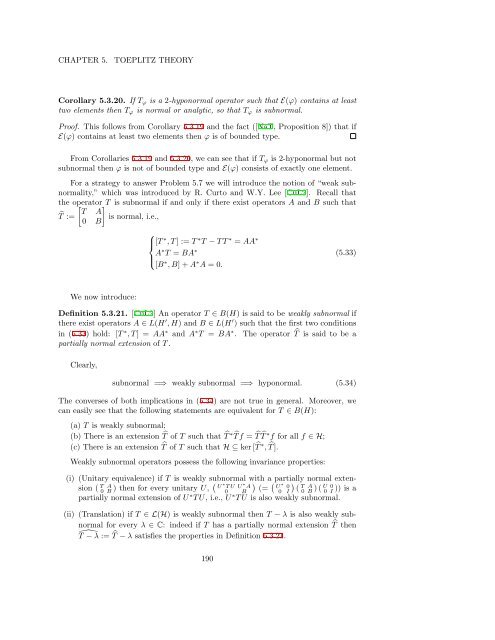Woo Young Lee Lecture Notes on Operator Theory
Woo Young Lee Lecture Notes on Operator Theory
Woo Young Lee Lecture Notes on Operator Theory
You also want an ePaper? Increase the reach of your titles
YUMPU automatically turns print PDFs into web optimized ePapers that Google loves.
CHAPTER 5.<br />
TOEPLITZ THEORY<br />
Corollary 5.3.20. If T φ is a 2-hyp<strong>on</strong>ormal operator such that E(φ) c<strong>on</strong>tains at least<br />
two elements then T φ is normal or analytic, so that T φ is subnormal.<br />
Proof. This follows from Corollary 5.3.19 and the fact ([NaT, Propositi<strong>on</strong> 8]) that if<br />
E(φ) c<strong>on</strong>tains at least two elements then φ is of bounded type.<br />
From Corollaries 5.3.19 and 5.3.20, we can see that if T φ is 2-hyp<strong>on</strong>ormal but not<br />
subnormal then φ is not of bounded type and E(φ) c<strong>on</strong>sists of exactly <strong>on</strong>e element.<br />
For a strategy to answer Problem 5.7 we will introduce the noti<strong>on</strong> of “weak subnormality,”<br />
which was introduced by R. Curto and W.Y. <str<strong>on</strong>g>Lee</str<strong>on</strong>g> [CuL2]. Recall that<br />
the operator [ ] T is subnormal if and <strong>on</strong>ly if there exist operators A and B such that<br />
T A<br />
̂T := is normal, i.e.,<br />
0 B<br />
⎧<br />
⎪⎨ [T ∗ , T ] := T ∗ T − T T ∗ = AA ∗<br />
A<br />
⎪⎩<br />
∗ T = BA ∗<br />
[B ∗ , B] + A ∗ A = 0.<br />
(5.33)<br />
We now introduce:<br />
Definiti<strong>on</strong> 5.3.21. [CuL2] An operator T ∈ B(H) is said to be weakly subnormal if<br />
there exist operators A ∈ L(H ′ , H) and B ∈ L(H ′ ) such that the first two c<strong>on</strong>diti<strong>on</strong>s<br />
in (5.33) hold: [T ∗ , T ] = AA ∗ and A ∗ T = BA ∗ . The operator ̂T is said to be a<br />
partially normal extensi<strong>on</strong> of T .<br />
Clearly,<br />
subnormal =⇒ weakly subnormal =⇒ hyp<strong>on</strong>ormal. (5.34)<br />
The c<strong>on</strong>verses of both implicati<strong>on</strong>s in (5.34) are not true in general. Moreover, we<br />
can easily see that the following statements are equivalent for T ∈ B(H):<br />
(a) T is weakly subnormal;<br />
(b) There is an extensi<strong>on</strong> ̂T of T such that ̂T ∗ ̂T f = ̂T ̂T ∗ f for all f ∈ H;<br />
(c) There is an extensi<strong>on</strong> ̂T of T such that H ⊆ ker [ ̂T ∗ , ̂T ].<br />
Weakly subnormal operators possess the following invariance properties:<br />
(i) (Unitary equivalence) if T is weakly subnormal with a partially normal extensi<strong>on</strong><br />
( T 0 B A ) then for every unitary U, ( ) ( )<br />
U ∗ T U U ∗ A<br />
0 B (= U ∗ 0<br />
0 I (<br />
T A<br />
0 B ) ( U 0 I 0 )) is a<br />
partially normal extensi<strong>on</strong> of U ∗ T U, i.e., U ∗ T U is also weakly subnormal.<br />
(ii) (Translati<strong>on</strong>) if T ∈ L(H) is weakly subnormal then T − λ is also weakly subnormal<br />
for every λ ∈ C: indeed if T has a partially normal extensi<strong>on</strong> ̂T then<br />
̂T − λ := ̂T − λ satisfies the properties in Definiti<strong>on</strong> 5.3.21.<br />
190













